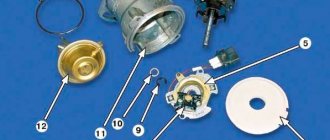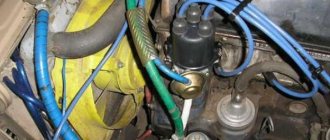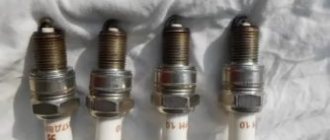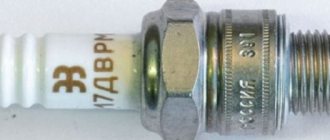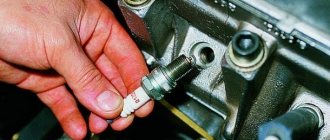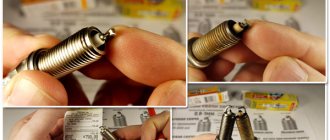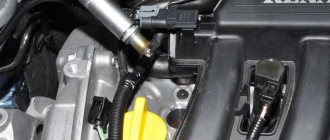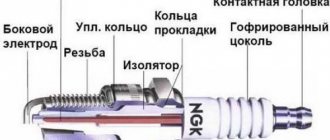Any motorist knows that spark plugs are used in a gasoline engine. The principle of their operation is quite simple and intuitive, but they can still hide many problems. The service life of spark plugs is very long, it all depends on whether the carburetor or injector supplies fuel. It should be noted that replacing a spark plug on a VAZ 2107 may not bring the expected result, since the service life of parts is affected by the technical condition of the engine and other systems.
For the VAZ 21074 carburetor, only those models of spark plugs that are designed for this type of injection are suitable. If an injector is installed in the car, the requirements will be slightly different. The type of ignition system is also important in determining the spark plug parameters used for a particular engine. In addition, many problems can be diagnosed by the color of the electrode. Experience and logic will help answer the question why candles are black or reddish.
How to choose the right spark plugs
A mistake in choosing spark plugs can “kill” the engine.
Spark plugs can affect fuel consumption. There are “incompatible” spark plugs and high-voltage wires. In this article, we'll look at what you really need to know and consider if you service your car yourself. After all, this small device, which looks so simple, is in fact a complex and high-tech product with strictly adjusted dimensions, made from materials specially designed for candles. Spark plug device
Device
The candle is assembled in a metal case, which has a threaded part (thread diameter from 8 to 18 mm) and a hexagon (from 13 to 25.4 mm). A ceramic insulator is installed in the housing, with an electrode running through the center. The lower part of the insulator forms a thermal cone, which is placed on a heat sink for better heat removal. Depending on the design, a resistor or glass sealant is placed between the central electrode and the contact rod. The assembled insulator is rolled into the housing. In the lower part, one or more side electrodes are welded to the end of the housing.
“Hot” and “cold” or what is the heat rating
The part of the spark plug that is inside the combustion chamber must have a strictly defined temperature when the engine is running at full power - from 500 to 600 degrees Celsius. Engines with different degrees of boost have different thermal load, based on which the size of the thermal cone and the contact area between it and the housing are selected.
If the temperature is lower, the candle will not “self-clean” and will become covered with soot. After some time, the electrodes will close and the spark plug will stop working. This happens when the installed spark plugs are too “cold” - they have too high a heat rating: for example, if instead of A17 you install A23, the engine “doesn’t like” such spark plugs, it will begin to have difficulty starting, often “triple”, and shake at idle. The engine loses power and gasoline consumption increases. This is, of course, bad.
It is much worse when spark plugs that are too “hot” are installed in the engine, that is, those with a lower heat rating. Due to the high temperature of the electrodes and the thermal cone of the insulator, the combustible mixture, entering the cylinder, is ignited not by a spark, but by the hot parts of the spark plug. This happens “spontaneously” - sometimes earlier, sometimes later, the engine suddenly loses power, runs after the ignition is turned off, and the valves and piston may “burn out.”
Highly accelerated, high-speed engines are usually equipped with “cold” spark plugs. They feel great under heavy loads, but long periods of idling or light loads will lead to the formation of a layer of carbon deposits.
Engines with an average degree of boost, for example VAZ engines, require spark plugs with an average heat value.
Low-speed, non-boosted engines are equipped with spark plugs with low heat ratings - “hot”.
What you need to know about the marking of spark plugs and which ones to put on the VAZ-2107
According to domestic GOSTs, this is A17DVRM , where 17 is the heat number (candles are produced from 10 to 23 units). The remaining letters indicate design and dimensional features. Today we need the letter “P” to indicate that a noise suppression resistor is built into the spark plug.
Here is an example of NGK markings: BPR6ES11 . Here the number 6 is the heat number (on a scale from 2 to 13 units), the letter R indicates the presence of a resistor. Expensive brands of candles have the letter “Z” instead of “R” - this is an inductive resistor, it does not lead to loss of spark energy. The number “11” at the end of the mark indicates a gap of 1.1 mm. These spark plugs are suitable for injection "seven".
For carburetor models, choose spark plugs without the letter “P” or “R” in the marking: A17DVM, BP6E . They do not have a built-in noise suppression resistor, which will weaken the already not very powerful spark.
Expensive spark plugs with platinum and iridium electrodes have good performance and last a very long time. But it is very difficult to find a model for carburetor engines among them - they all come with a built-in resistance. The solution is to choose a model with an inductive resistor (Z in the marking).
Below you can see recommendations for candles from other manufacturers.
For classic VAZ models with contact ignition
- BERU W7D
- BOSCH W7D
- BRISK L15Y
- CHAMPION N10Y
- DENSO W20EP
- EYQUEM 707LS
- MARELLI FL7LP
- FINVAL F501
- HOLA S12
- WEEN 121-1371. The gap between the electrodes should be 0.5-0.7 millimeters.
For models with contactless protection
- BERU 14-7D, 14-7DU, 14R-7DU
- BOSCH W7D, WR7DC, WR7DP
- BRISK L15Y, L15YC, LR15Y
- CHAMPION N10Y, N9Y, N9YC, RN9Y
- DENSO W20EP, W20EPU, W20EXR
- EYQUEM 707LS, C52LS
- MARELLI FL7LP, F7LC, FL7LPR
- FINVAL F508
- HOLA S13
- WEEN 121-1378. And the gap here is needed a little more - 0.7-0.8 millimeters.
For injection engines
- BERU 14R7DU
- BOSCH WR7DC
- CHAMPION RN9YC
- DENSO W20EPR
- EYQUEM RC52LS
- MARELLI F7LPR
- FINVAL F510
- HOLA S14
- WEEN 121-1370. The gap size here is larger - 0.9-1.0 millimeters.
This list, of course, is not complete; there are a lot of manufacturing companies.
How to choose high-voltage wires
An error in the choice of wires can lead to poor engine starting, increased fuel consumption, unstable operation and “dullness” during acceleration. The thing is that the wires are now made of silicone, with a graphite central core and increased distributed resistance. This is done to reduce the level of electromagnetic interference that can interfere with the operation of numerous on-board electronics. Injector ignition systems have very high spark energy and these wires are ideal for them. But for carburetor cars, wires need to be selected with the least resistance. The best you can find is from 2 to 4 kilo-ohms per wire; “zero” wires with a copper core cannot be found on sale at all. How to choose? Take a multimeter with you and ask the seller for permission to “measure” several sets from different manufacturers. And sometimes the resistance value of the wires is marked on the packaging. In the distributor of carburetor cars, or rather in its “runner”, another noise suppression resistor is installed. This “relic of the past” needs to be replaced with a suitable piece of wire, because the function of this element is now performed by high-voltage wires.
To summarize:
Do not use spark plugs with a low heat rating - they can “kill” the engine.
Candles with the letter “P” or “R” in the marking are suitable only for injection engines.
For carburetor cars, choose high-voltage wires with minimal resistance; replace the resistor from the slider with a piece of wire.
On classic cars VAZ 2101, 2102, 2103, 2104, 2105, 2106, 2107, two ignition systems are used: contact and non-contact.
For each ignition system of these VAZ vehicles, spark plugs of different design and characteristics are required. The reason for this is different ignition coils with different characteristics used in contact and contactless systems.
For example, the B-117-A ignition coil is used in the contact ignition system of VAZ cars and has a spark discharge energy of 18-20 mJ, and in the contactless ignition system of the same cars, an ignition coil 27.3705 is installed with a much higher spark discharge energy of 40-50 mJ. Therefore, the use of spark plugs for a contact system in a non-contact system can lead to destruction of the spark plug electrodes due to a more powerful spark.
Differences between spark plugs for contact and non-contact systems
Contact ignition system
Spark plugs without an interference suppression resistor with a gap between the electrodes of 0.5 - 0.6 mm.
Examples of spark plugs for the contact system of VAZ 2101-2106, 2105, 2107 cars: A17DV, A17DV-10.
spark plug A17DV for contact ignition system
Contactless ignition system
Spark plugs with an interference suppression resistor and a gap between the spark plug electrodes of 0.7 - 0.8 mm (see photo at the beginning of the article). Designed for higher voltage and current than spark plugs for KSJ.
An interference suppression resistor is necessary to suppress radio interference that appears during operation of the ignition system, thereby reducing its negative impact on the operation of the vehicle’s electronic devices (switchboard, car radio).
Examples of spark plugs for a non-contact ignition system: A17DVRM, where the letter “P” indicates the presence of a resistor in the design of the spark plug.
Notes and additions
— Spark plugs for a contact ignition system can be installed in a contactless ignition system and vice versa without any noticeable losses in engine operation, but only for a while. It is not recommended to constantly operate a car with such a replacement for a long time. It is especially not advisable to switch contact to non-contact.
— The selection of spark plugs for a specific engine is made primarily by heat rating (hot or cold plugs). See “Applicability of spark plugs on VAZ engines“.
More articles on spark plugs for VAZ cars
Self-identification of problems
The procedure is not difficult. The easiest way is visual. The most difficult one involves a detailed study of the engine’s performance.
One of the obvious signs of these breakdowns is a malfunction in the engine. For example, it may be difficult to start, or it may have an idle speed.
Other signs are:
- The first is related to the rotation of the crankshaft. If it rotates at the required frequency, but the engine itself does not start, this is a sign of lack of ignition. In other words, the air mixture does not ignite.
- If a mixture of fuel and air flares up in the cylinders, the engine may operate extremely unstable.
- When starting the engine, the starter does not function. As a result, the engine also fades out.
- Very high fuel costs. If the composition of fuel and air does not ignite, then the power of the power unit is reduced or drops to zero. Power losses can be compensated by supplying an increased dose of fuel to the cylinders. And the result is an impressive waste of fuel.
- The catalyst is not working. If there is no ignition in the technology, there is no combustion of the air-fuel composition. And the fuel that does not ignite ends up in the catalyst. And there it oxidizes. And the catalyst stops functioning.
- A cold engine does not start well. When turning the ignition, cold ones accumulate condensation. And it is considered an excellent conductor of electricity. If the distance between the electrodes increases, then the degree of breakdown voltage should develop. It cannot be developed independently, because the energy will be eliminated through the indicated electrodes, as well as through a ceramic cone.
- There are traces of mechanical defects on the surface. This is a sign of either complete breakdown or malfunction.
- There are carbon deposits and deposits on the electrodes. The candles themselves smell like fuel. This is evidence that the system itself, and every single one of them, is faulty.
- A damaged cable carrying high voltage can seriously impair normal operation.
see also
Pouring candles when cold
- 5 0 6k
Replacing spark plugs on a Z18XE engine
- 8 0 3k
Spark plug and coil lubricant
- 66 3 86k
How to check spark plugs
- 72 4 99k
No spark
- 98 7 221k
VAZ 2106, 2107, 2108 and 2109 cars are very similar to each other in their design and engines. However, they were produced with both an injector and a carburetor, so when choosing spark plugs you need to focus on the fuel system and ignition option (contact or non-contact). The manufacturer of original spark plugs for all of the above cars is the Russian company “E3”, Engels.
According to the rating of spark plugs for the VAZ 2106 on PartReview dated 05/07/20, owners prefer NGK products. Manufacturers BRISK, Denso and Finwhale also stand out.
NGK 7529 BP6E
NGK 7529 BP6E
The spark plugs are universal and work across the entire range of temperatures and loads. They are resistant to the formation of deposits on the insulator, maintain the shape of the electrodes and the size of the gap. V-line technology ensures uninterrupted sparking. The copper rod in the central electrode removes heat, preventing overheating and damage to the insulator. The sealing of the housing is adequately done, the tightness is always at its best.
The gap for these spark plugs is 0.9 mm. This means that it is better not to use the product for a carburetor engine, only an injector.
The price for such quality is attractive and does not go out of the general range in the category.
The cost of candles is, on average, 150 rubles per piece.
Advantages and disadvantages
Good engine starting in any weather. Sparking without interruption due to the use of new technology. Excellent tightness. Compliance price/quality.
There are often fakes on the market
Spark plugs for VAZ 2106, 2107, 2108 and 2109 – which ones to install?
The technical characteristics of spark plugs for engines of cars 2106/2107/2108/2109 differed from the fuel supply system to the combustion chamber. On VAZ 2106 and 2107 with carburetors and a contact ignition system, spark plugs with article number 21010-3707010-86 are provided from the factory. For carburetor 2106/2107/2108/2109 but with contactless ignition, spark plugs with article numbers 2108-3707010-86 or 21080-3707010-86 were installed. But in fact it is the same spare part. They are interchangeable. But on injection cars of this series, the spark plugs were somewhat different.
With injection engines on VAZ 2107, 2108 and 2109, spark plugs with article numbers 21110-3707010-86, 21110-3707010-00 or 2111-3707010 were installed. The main difference between spark plugs on injection and carburetor engines is the gap size. Otherwise, all these are ordinary nickel single-pin spark plugs with a heat rating of 17 and a tightening torque of 22 Nm.
If we talk about the rating of spark plugs for the VAZ 2107 on PartReview, owners prefer Bosch products. Manufacturers BRISK, Denso and NGK also stand out.
The rating of spark plugs on PartReview for VAZ (Lada) 2108/2109 says the following, owners buy the following brands BRISK, Finwhale, Champion and Denso.
Read more about the sizes of original spark plugs in the table.
| vendor code | Engine | Thread / thread length, mm | Key size | Gap, mm | Heat number* | Center electrode material |
| 21110-3707010-86, 21110-3707010-00, 2111-3707010 | Injection 1.5, 1.6, 1.7 | M14×1.25 / 19 | 21 | 1 | 17 | Nickel |
| 21010-3707010-86, 2108-3707010-86, 21080-3707010-86 | Carburetor 1.1, 1.3, 1.5, 1.6 | M14×1.25 / 19 | 16 | 0.7 | 17 | Nickel |
*According to Champion nomenclature (Russian standard)
Also, original candles can be found directly from the manufacturer, the Engels plant. The article number of spark plugs for injection engines is A17DVRM, for carburetor engines there are several options - A17DVR, A17DV-10, A17DVM.
The most well-known and frequently used substitutes from other manufacturers are presented below in the list.
| Manufacturer | vendor code | Price, rub (for 1 piece) |
| Analogues for injectors | ||
| Bosch | 0242235663 | 100 |
| Denso | W20EPR-U | 100 |
| Analogues for carburetors | ||
| NGK | BPR6ES | 140 |
| Denso | W20EPU | 80 |
Sometimes, even though these are old and super-budget cars, their owners install iridium DENSO IW20TT, price - 610 rubles / piece, or platinum Bosch 0242235540 at a price of 200 rubles / piece. Both models are equally suitable for injectors and carburetors. But nevertheless, this is a little justified waste.
When to change spark plugs on VAZ 2106, 2107, 2108 and 2109?
According to VAZ 2106/2107/2108/2109 maintenance regulations, spark plugs must be changed every 30 thousand km, that is, after one maintenance. But, in fact, their actual lines are half as large, and usually drivers change them at every maintenance service, every 15 thousand km.
Good afternoon, dear readers! I decided to devote today’s post to adjusting the spark plug gaps on a VAZ 2107 car. If you have problems starting the car engine, engine tripping, then I recommend that you read this article. Perhaps she can solve your problem.
The spark plug gap is the gap between the side and center electrodes of a car spark plug. Depending on the type of engine and power system, the spark plug gap may have one or another value. Typically, at a spark plug manufacturing plant, the gap is already set and does not need to be adjusted, although it can be corrected.
Non-traditional schemes
Some of the design solutions in spark plugs of an unconventional design can be called conditionally working - by improving one thing, they worsen another. The simplest example is the NGK V-Line series of spark plugs: their central electrode has a groove, so the spark always jumps between the edge of the electrode and the side one. In theory, this improves ignition of the mixture by moving the spark into a better ventilated space and stabilizing the spark point, but the erosion of such a central electrode is accelerated.
Some of the candles on the market cannot be classified as anything other than “Herbalife” from the car market: all sorts of “pre-chamber”, “torch” and so on candles, at best, work no better than standard ones, at worst, they quickly deteriorate. For example, in the notorious “Bugaets” candles, the soldered skirt not only worsened the ventilation of the spark gap, but also burned out, and sometimes went into “free flight” into the combustion chamber. Of the designs that are workable, but useless in the practice of an ordinary motorist, we note only spark plugs that do not have a side electrode at all - they were originally created to work in ultra-high boost engines in order to avoid overheating of the protruding side electrodes; in a normal city cycle on a “civilian” boost level motor, they They clean themselves disgustingly and guarantee rough idling even on ideal quality gasoline.
How to measure the spark plug gap in a VAZ 2107 car
The spark plug gap in a VAZ 2107 can be measured with a special probe. It should pass between the spark plug electrodes with barely perceptible resistance. If necessary, it must be adjusted down or up. Although, by and large, candles are relatively inexpensive and it’s easier to carry an additional set of candles with you so that, if anything happens, they can replace the previously installed ones.
A lot depends on the correct spark plug gap. If the gap is larger, fuel consumption will increase. If it is less, the engine will start to jerk or refuse to work at all. As mentioned above, the gap depends on the engine power supply system. For example, in a VAZ 2107 and with a carburetor engine, the spark plug gap with a contact ignition system is 0.5-0.6 mm. If the system is non-contact, then the gap is larger and is 0.7 -0.8 mm. If an injector is installed on the seven, then the gap is already 1 - 1.3 mm.
In general, injection engines always have a larger spark plug gap. Cars with injectors have more powerful coils and better design of high-voltage wires. They maintain a gap of 1 mm. If, for example, you put spark plugs from a carburetor V8 on a Kalina, with a gap of 0.7 -0.8 mm, it will run without problems, although the performance characteristics will deteriorate. But if you put spark plugs from Kalina with a gap of 1.1 on the same “eight”, then most likely it won’t run.
Before you go to the store to buy a spark plug, read the instructions for your car. It usually indicates what type of candle, with what marking, should be used. It is better to buy spark plugs from well-known manufacturers such as Bosch, NGK, Denso, Finwhale, Brisk and others. In most cases, you will thereby protect yourself from marriage.
And don’t forget that spark plugs on a car cannot last forever and they need to be changed periodically. The frequency of replacement is also written in the instructions. Usually this is from 15 to 30 thousand km.
HOLA S12
HOLA S12
S12 spark plugs provide good performance. The technologies used operate under worse conditions than the intended purpose of budget devices. A distinctive feature is uninterrupted operation when installing gas equipment on a car.
The product has a small gap, which is why it can work well on old AvtoVAZ engines, including at low temperatures.
Reliability is acceptable, but does not allow this product to be ranked among the best in the rating. Other average indicators correspond to the price, you can buy with confidence.
The average cost per unit is 110 rubles.
Advantages and disadvantages
Possibility of installation on cars with LPG. Reasonable price. Starting the engine at low air temperatures. Application of innovative technologies in manufacturing.
Low reliability due to manufacturing defects
How to check spark plugs in a VAZ 2107 - step-by-step instructions
Attention: When performing the following operation, do not pull on the high-voltage wire. Force should only be applied to the tip of the high-voltage wire.
- Remove the tip of the high-voltage wire from the spark plug.
- We clean the dirt from the cylinder head and blow it with compressed air around the spark plug.
- Using a 21mm spark plug wrench or a deep socket wrench, remove the spark plug from the threaded hole in the cylinder head.
- Visually assess the condition of the spark plug.
- For a working spark plug, when the engine is adjusted on a VAZ 2107 car, carbon deposits on the spark plug insulator should be from gray-yellow to gray-brown. If carbon deposits on the spark plug are black, the spark plug may be faulty or the engine adjustments may be incorrect. If the spark plug insulator is cracked or damaged, the spark plug must be replaced.
- Using a round feeler gauge, check the gap between the electrodes at the spark plug. If the spark plug gap does not meet the standard, set the spark plug gap according to the table. 13.3, bending or bending the side electrode.
- We install a spark plug in the engine of a VAZ 2107 car, wrapping it by hand, and then tighten it with a wrench to a torque of 3-4 kgf-m.
- Similarly, we replace the spark plugs of other cylinders on a VAZ 2107 car.
Caution: Over-tightening the spark plug may damage the cylinder head bore threads.
Noble metals: practical meaning of application
As we already said in the last paragraph, the transition to a multi-electrode circuit did not bring much practical benefit in increasing the service life of spark plugs. In fact, the fight against the very cause of natural wear of spark plugs, that is, erosion of contacts, was replaced with a palliative - the substitution of “spare” ones. To increase the immediate reliability of the electrodes, the design of the spark plugs was significantly redesigned.
In “platinum” and “iridium” spark plugs, the main feature that catches the eye is a very thin central electrode, which precisely localizes the point of origin of the spark - opposite it, a plaque of the corresponding metal is soldered on the side electrode, and the central electrode is also covered with it.
The advantages of such candles are obvious: the electrodes have a service life that, under normal conditions, is two to three times longer than that of conventional candles. The thin central electrode is perfectly self-cleaning, which also contributes to reliable operation.
The disadvantages, alas, are also significant. The first is the price: a set with the Platinum or Iridium inscription will cost at least two to three times more than regular candles. The second, oddly enough, is tenderness: non-fading carbon deposits instantly kill such candles, and mechanical cleaning is contraindicated for them, just like the old-fashioned burning with a torch. First of all, we are, of course, talking about the notorious ferrocene, which is still not uncommon to encounter.
Correct gap on spark plugs VAZ 2107 carburetor
The gaps in the spark plugs should be set depending on the ignition system and power system. If the spark plug gap is larger than required, gasoline consumption will increase; if the gap is smaller than required, the car will jerk at low speeds.
According to the operating manual for VAZ-2105, VAZ-2107, the gap between the spark plug electrodes for a contact ignition system (KSZ) should be 0.5-0.6 mm, for a contactless ignition system (BSI) - 0.7-0.8 mm, spark plug gaps in an injection engine are 1.0-1.3 mm.
In summer, the gap in the spark plugs can be slightly increased, in winter - reduced, literally by 0.1-0.15 mm.
Below are several options for the condition of the spark plugs, from which you can draw conclusions about the operation of the engine:
- The electrodes of the spark plugs are covered with black carbon deposits - the fuel mixture is over-rich; the carburetor needs to be checked.
- spark plug electrodes are covered with a whitish coating - the fuel mixture is too lean
- burnt out electrodes may be due to an incorrectly selected type of spark plug, too early ignition angle, or the use of poor gasoline (low octane number)
- Oily electrodes - usually appear on the engine with age and indicate the need to repair the piston group.
Recommendations for replacement intervals
According to official recommendations, replacement of spark plugs is required every 30 thousand km. In real conditions, low fuel quality causes consumables to fail by 12-15 thousand km. The need for replacement can be determined by the following symptoms:
- there is a missing spark;
- During the inspection, black spark plugs with irremovable carbon deposits were found;
- Any damage shown in the image below has been identified.
Damage to spark plugs
Why iridium?
Installing the ignition on a VAZ 2107 carburetor, marks, gap in breaker contacts, checking ignition
Such a wide selection of candles pampers car enthusiasts only for 20-25 years. Before this, the choice was much poorer.
Platinum candles were already on sale, but one could only dream of decent quality or reliability.
The best manufacturers in the world did everything possible to improve the quality of the product and achieve their goals, namely ensuring maximum reliability, long service life and reducing energy consumption.
In 1994, NGK specialists finally managed to create high-quality spark plugs using a special material - iridium.
What are its advantages? — It has a maximum melting point (in this indicator, iridium surpasses even platinum), excellent anti-corrosion properties and high quality.
The developers managed to make the thickness of the electrode minimal. Moreover, it was the tip that was made of rare metal.
In terms of its hardness, iridium occupies one of the leading positions. Many believe that the metal is based on the material of a meteorite that arrived on our planet many millions of years ago. Hence its hardness indicators.
Another advantage of iridium is its ability to withstand high temperatures. Metal can only be melted when heated to 2,500 degrees Celsius.
Iridium has been actively used in the industrial sector (since the 20s of the last century). But in practice it is not used in its pure form, but in the form of a special alloy.
POPULAR WITH READERS: How to properly adjust the parking brake
This is not surprising, because without the addition of metals, iridium is extremely fragile and useless in production. That is why in practice only alloys are used.
Product delivery options
Note! Below are the shipping methods available specifically for this product. Payment options may vary depending on the delivery method.
Detailed information can be found on the “Delivery and Payment” page.
Parcel by Russian Post
Available payment methods:
- Cash on delivery (payment upon receipt)
- Using cards Sberbank, VTB, Post Bank, Tinkoff
- Yandex money
- QIWI
- ROBOKASSA
Shipping throughout Russia. Delivery time is from 5 to 12 days.
Parcel by Russian Post 1st class
Available payment methods:
- Cash on delivery (payment upon receipt)
- Using cards Sberbank, VTB, Post Bank, Tinkoff
- Yandex money
- QIWI
- ROBOKASSA
Shipping throughout Russia. Delivery time – from 2 to 5 days. More expensive than regular delivery by Russian Post, approximately 50%. Parcel weight up to 2.5 kg
Express Parcel EMS
Available payment methods:
- Cash on delivery (payment upon receipt)
- Using cards Sberbank, VTB, Post Bank, Tinkoff
- Yandex money
- QIWI
- ROBOKASSA
Shipping throughout Russia. Delivery time – from 3 to 7 days. More expensive than regular delivery by Russian Post, approximately 100%.
Transport companies
Available payment methods:
- Using cards Sberbank, VTB, Post Bank, Tinkoff
- Yandex money
- QIWI
- ROBOKASSA
Delivery is possible to any locality where there is a representative office of the transport company. Delivery time – from 2 to 10 days. Sending large parcels is approximately 50% more profitable than by Russian Post.
Selection options
To select good SZ, you must be guided by the following criteria:
The first parameter to consider when purchasing is the heat rating. It should be noted that this parameter is conditional and not universal, so it must be selected in accordance with the model of a particular motor. This number shows the pressure level in the internal combustion engine cylinder at which glow ignition occurs. The use of SZ with a higher heat number is allowed, but is not prohibited if it is lower. Another parameter is the possibility of self-cleaning. Unfortunately, this parameter can only be accurately verified in practice, since all SZ manufacturers promise consumers a high level of self-cleaning
If this indicator is really high, then carbon deposits will not form on the SZ, which is especially important for their optimal operation. When buying spark plugs from a VAZ, you also need to take into account their gap. Each manufacturer sets the appropriate gap for individual product lines
If we are talking about domestically produced cars, then in this case this gap on the VAZ spark plugs should be 0.5-0.7 mm. Traditional SZ are equipped with two electrodes - one central and one side, but not so long ago global manufacturers began producing devices with 3 and 4 electrodes. These electrodes cannot produce multiple sparks - their purpose is to provide more consistent sparking. Accordingly, the use of such SZ contributes to more stable operation of the power unit due to improved ignition procedures. Before purchasing SZ, carefully inspect them for mechanical damage. If you see that there are cracks on the device’s body, then it is better to refuse to purchase such SZ. Also, before installation, check that the gap is the right size. To diagnose purchased SZ, you can install them in a pressure chamber, of course, if you have such an opportunity, then adjust the pressure in it to about 10 kg/cm2, and the current should be connected with a value of 22 kV. As a result, a spark should begin to form. If the spark appears intermittently, this indicates that the SZ is not working, but if the sparking is continuous, then the devices can be purchased (the author of the video is Nail Poroshin).
Checking the contact distributor
Which spark plugs are best for the Lada Granta 8 valve: the top 9 best spark plugs, which ones are best to install
The need to check the distributor-distributor appears if problems arise with sparking, but during the diagnosis of the ignition system elements the problem could not be identified.
Cover and rotor
First of all, we inspect the cover and rotor of the device. The check consists of the following steps:
- We dismantle the distributor cover and inspect it inside and out. There should be no cracks, chips, or burnt contacts on it. If damage is found, the part must be replaced.
- We check the carbon contact by pressing with a finger. It should press easily.
- We check the rotor insulation for breakdown by placing the explosive wire from the coil near the rotor electrode and manually closing the contacts of the distributor, after turning on the ignition. If a spark appears between the cable and the electrode, the rotor is considered faulty.
contact Group
The main malfunctions of the ignition distributor contact group are burnt contacts and incorrect clearance between them. In case of burning, the contacts are cleaned with fine sandpaper. If they are severely damaged, it is better to replace them. As for the gap itself, to check it it is necessary to remove the cover of the distributor-breaker and turn the engine crankshaft so that the cam on the distributor shaft opens the contacts as much as possible. We check the gap with a feeler gauge and if it differs from the norm, then we adjust the contacts by unscrewing the corresponding screws and moving the contact plate.
The contacts are adjusted by unscrewing the corresponding screws and moving the contact plate
Capacitor
If a capacitor is installed on the distributor of your “six”, then sometimes the part can fail as a result of a breakdown. The malfunction appears as follows:
- problems starting the engine;
- sudden engine stop while driving.
If the distributor capacitor fails, engine operation malfunctions
You can check an element in the following ways:
- Control lamp. Disconnect the wiring coming from the coil and the capacitor wire from the distributor according to the figure. We connect a light bulb to the open circuit and turn on the ignition. If the lamp lights up, it means that the part being tested is broken and requires replacement. If not, then it's OK.
- Wire from the coil. Disconnect the wires as in the previous method. Then turn on the ignition and touch the tips of the wires to each other. When sparking occurs, the capacitor is considered faulty. If there is no sparking, then the part is working.
What is iridium?
Choosing which spark plugs are better for a Priora 16 valves
Iridium is a very hard metallic element. It is believed that this material was formed on our planet due to meteor showers many years ago. It is precisely because this metal has high hardness that it is used as an electrode material for the manufacture of spark plugs
Its second important property is melting at a temperature of about 2,800°C.
Very reliable, have a long service life and are resistant to temperature changes - all these are iridium spark plugs. Reviews from owners of cars “filled” with this metal confirm this fact on thematic forums.
Since the 80s of the last century, this material began to be actively used as an alloy for igniters in industrial production. Due to its fragility and low electrical conductivity, this metal cannot be used in its pure form. Only in alloys does iridium show its best properties.
